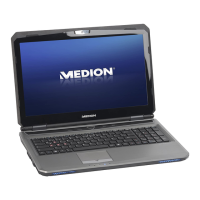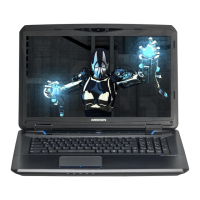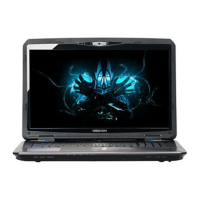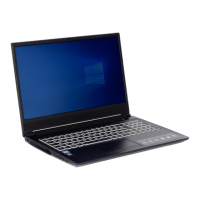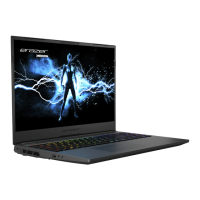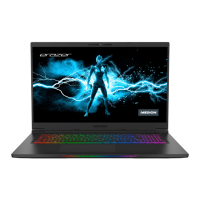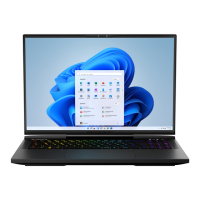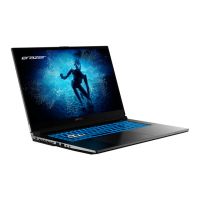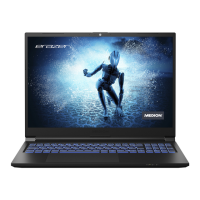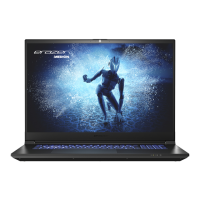Do you have a question about the Medion Erazer Crawler E25 MD62301 and is the answer not in the manual?
Explains warning symbols used in the manual to indicate potential hazards and their meanings.
Defines the intended purpose of the device and prohibits modifications or use outside specified conditions.
Provides technical details and regulatory information regarding the device's Wireless LAN capabilities and country usage.
Details potential risks for children and individuals with limited abilities, including suffocation hazards from packaging.
Outlines general safety procedures for reliable operation and extending the notebook's service life, including handling liquids and electrical safety.
Warns against user repairs, emphasizing risks of electric shock and advising contact with service centers for faults.
Specifies suitable indoor environments and recommends avoiding areas with explosion risks, moisture, dust, heat, or interference.
Details optimal operating temperature and humidity ranges, and storage conditions, including protection against power surges.
Provides safety precautions for the AC adapter, socket outlet requirements, and recommended surge protection devices.
Warns about battery explosion risks from improper handling, heating, or disposal, and provides guidelines for safe charging and usage.
Offers advice on cable positioning, avoiding damage, using shielded cables, and maintaining distance from interference sources.
Explains the touchpad's sensitivity, how to operate it correctly, and how to clean it to maintain performance.
Highlights the display's fragility, advises against stress, scratches, and improper lifting, and provides safety advice for broken screens.
Recommends backing up data to external media before updates to prevent data loss and associated claims.
Offers guidance on proper posture, screen positioning, and lighting to protect eyes and prevent physical strain during use.
Illustrates the top view of the open notebook, identifying key components like microphones, webcam, display, keyboard, and touchpad.
Details the ports and openings on the rear side of the notebook, including ventilation, Mini DisplayPort, HDMI, LAN, and power input.
Shows the rear side of an alternative notebook version, highlighting ports like HDMI, USB 3.2 Type C with DisplayPort, LAN, and ventilation.
Illustrates the left side of the notebook, identifying Kensington lock, USB ports (3.2 Gen1, 2.0), microphone, and audio combi connection.
Depicts the left side of a different notebook version, showing Kensington lock, power supply input, and USB 3.2 ports (Type A).
Displays the right side of the notebook, identifying ventilation openings and USB ports (3.2 Gen1 Type A, 3.2 Gen2 Type C).
Illustrates the right side of another notebook version, detailing microphone, audio combi connection, USB 2.0 port, and ventilation openings.
Shows the underside of the notebook, identifying ventilation openings, battery compartment, and stereo speakers.
Describes how to operate the notebook's power switch, including troubleshooting for unresponsive power buttons and safe shutdown procedures.
Details the initial startup process, including language selection, internet connection, and Windows license agreement, with tips for first-time use.
Explains the secure transport mode and the procedure for the first-time power-on after unpacking.
Details the step-by-step process for inserting the notebook battery correctly into its compartment.
Provides instructions on how to safely remove the notebook battery, emphasizing the need to switch off the device first.
Advises operating the notebook on battery until it powers off to ensure proper discharge, with a warning about data loss.
Introduces the notebook's power-saving features and functions to optimize battery life and reduce operating costs.
Guides users on how to open and close the notebook display, emphasizing gentle handling and angle limitations to prevent damage.
Explains how to connect external monitors using HDMI and Mini DisplayPort, and optionally via USB Type C with DisplayPort function.
Introduces the notebook's keyboard layout, including the use of the Fn key for accessing additional functions and shortcuts.
Warns against using sharp objects on the touchpad, which can cause permanent damage, and advises on correct operation.
Explains how to connect external audio devices for enhanced sound output and how to adjust volume settings using keyboard shortcuts.
Details how to establish a network connection using an RJ45 cable to a computer, hub, or switch.
Explains how to establish a wireless network connection via Wi-Fi access points and provides guidelines for use in sensitive locations.
Describes Bluetooth technology for wireless communication, its applications, and usage restrictions in sensitive environments.
Explains that airplane mode disables all wireless connections like Wi-Fi and Bluetooth for use during flights.
Guides on setting a power-on password via UEFI for protection against unauthorized use, with a warning about modifying settings.
Explains how to use a Kensington lock to secure the notebook against theft by attaching a steel cable to a stationary object.
Provides instructions on setting up and removing a fingerprint sensor for enhanced security and convenient login via Windows Hello.
Details the process of using Cyberlink PowerRecover or Windows recovery options to reinstall software and restore the system.
Describes how to refresh or reset the notebook using Windows recovery options, explaining data retention differences between refresh and reset.
Provides step-by-step instructions for refreshing the notebook via Windows settings to reinstall the OS while keeping personal files.
Details the process for resetting the notebook through Windows settings, which removes all data and reinstalls Windows.
Guides users on how to access and run the UEFI configuration program by pressing the F2 key during system startup.
Offers initial troubleshooting steps for hardware malfunctions and advises contacting customer service if problems persist.
Recommends checking all cable connections, including those to peripheral devices, as a first step in diagnosing hardware issues.
Provides contact information for customer support and lists essential information to prepare before contacting the service team.
Explains the need for driver updates due to compatibility issues and directs users to the homepage for current drivers and updates.
Offers guidance on safely transporting the notebook, including switching it off, protecting it from environmental factors, and packing it securely.
Provides instructions for cleaning the notebook safely, including warnings about electric shock and using appropriate cleaning agents.
Advises on proper storage of the notebook and its battery in a cool, dry place to protect them from dust and temperature extremes.
Explains how to activate battery protection in UEFI to prevent full discharge during long periods of non-use.
Provides specific instructions for service technicians regarding notebook housing access, replacement parts, and handling electrostatic discharge (ESD).
Details the standard for defining pixel defects on displays, categorizing faults and defect types based on sub-pixel behavior.
Explains warning symbols used in the manual to indicate potential hazards and their meanings.
Defines the intended purpose of the device and prohibits modifications or use outside specified conditions.
Provides technical details and regulatory information regarding the device's Wireless LAN capabilities and country usage.
Details potential risks for children and individuals with limited abilities, including suffocation hazards from packaging.
Outlines general safety procedures for reliable operation and extending the notebook's service life, including handling liquids and electrical safety.
Warns against user repairs, emphasizing risks of electric shock and advising contact with service centers for faults.
Specifies suitable indoor environments and recommends avoiding areas with explosion risks, moisture, dust, heat, or interference.
Details optimal operating temperature and humidity ranges, and storage conditions, including protection against power surges.
Provides safety precautions for the AC adapter, socket outlet requirements, and recommended surge protection devices.
Warns about battery explosion risks from improper handling, heating, or disposal, and provides guidelines for safe charging and usage.
Offers advice on cable positioning, avoiding damage, using shielded cables, and maintaining distance from interference sources.
Explains the touchpad's sensitivity, how to operate it correctly, and how to clean it to maintain performance.
Highlights the display's fragility, advises against stress, scratches, and improper lifting, and provides safety advice for broken screens.
Recommends backing up data to external media before updates to prevent data loss and associated claims.
Offers guidance on proper posture, screen positioning, and lighting to protect eyes and prevent physical strain during use.
Illustrates the top view of the open notebook, identifying key components like microphones, webcam, display, keyboard, and touchpad.
Details the ports and openings on the rear side of the notebook, including ventilation, Mini DisplayPort, HDMI, LAN, and power input.
Shows the rear side of an alternative notebook version, highlighting ports like HDMI, USB 3.2 Type C with DisplayPort, LAN, and ventilation.
Illustrates the left side of the notebook, identifying Kensington lock, USB ports (3.2 Gen1, 2.0), microphone, and audio combi connection.
Depicts the left side of a different notebook version, showing Kensington lock, power supply input, and USB 3.2 ports (Type A).
Displays the right side of the notebook, identifying ventilation openings and USB ports (3.2 Gen1 Type A, 3.2 Gen2 Type C).
Illustrates the right side of another notebook version, detailing microphone, audio combi connection, USB 2.0 port, and ventilation openings.
Shows the underside of the notebook, identifying ventilation openings, battery compartment, and stereo speakers.
Describes how to operate the notebook's power switch, including troubleshooting for unresponsive power buttons and safe shutdown procedures.
Details the initial startup process, including language selection, internet connection, and Windows license agreement, with tips for first-time use.
Explains the secure transport mode and the procedure for the first-time power-on after unpacking.
Details the step-by-step process for inserting the notebook battery correctly into its compartment.
Provides instructions on how to safely remove the notebook battery, emphasizing the need to switch off the device first.
Advises operating the notebook on battery until it powers off to ensure proper discharge, with a warning about data loss.
Introduces the notebook's power-saving features and functions to optimize battery life and reduce operating costs.
Guides users on how to open and close the notebook display, emphasizing gentle handling and angle limitations to prevent damage.
Explains how to connect external monitors using HDMI and Mini DisplayPort, and optionally via USB Type C with DisplayPort function.
Introduces the notebook's keyboard layout, including the use of the Fn key for accessing additional functions and shortcuts.
Warns against using sharp objects on the touchpad, which can cause permanent damage, and advises on correct operation.
Explains how to connect external audio devices for enhanced sound output and how to adjust volume settings using keyboard shortcuts.
Details how to establish a network connection using an RJ45 cable to a computer, hub, or switch.
Explains how to establish a wireless network connection via Wi-Fi access points and provides guidelines for use in sensitive locations.
Describes Bluetooth technology for wireless communication, its applications, and usage restrictions in sensitive environments.
Explains that airplane mode disables all wireless connections like Wi-Fi and Bluetooth for use during flights.
Guides on setting a power-on password via UEFI for protection against unauthorized use, with a warning about modifying settings.
Explains how to use a Kensington lock to secure the notebook against theft by attaching a steel cable to a stationary object.
Provides instructions on setting up and removing a fingerprint sensor for enhanced security and convenient login via Windows Hello.
Details the process of using Cyberlink PowerRecover or Windows recovery options to reinstall software and restore the system.
Describes how to refresh or reset the notebook using Windows recovery options, explaining data retention differences between refresh and reset.
Provides step-by-step instructions for refreshing the notebook via Windows settings to reinstall the OS while keeping personal files.
Details the process for resetting the notebook through Windows settings, which removes all data and reinstalls Windows.
Guides users on how to access and run the UEFI configuration program by pressing the F2 key during system startup.
Offers initial troubleshooting steps for hardware malfunctions and advises contacting customer service if problems persist.
Recommends checking all cable connections, including those to peripheral devices, as a first step in diagnosing hardware issues.
Provides contact information for customer support and lists essential information to prepare before contacting the service team.
Explains the need for driver updates due to compatibility issues and directs users to the homepage for current drivers and updates.
Offers guidance on safely transporting the notebook, including switching it off, protecting it from environmental factors, and packing it securely.
Provides instructions for cleaning the notebook safely, including warnings about electric shock and using appropriate cleaning agents.
Advises on proper storage of the notebook and its battery in a cool, dry place to protect them from dust and temperature extremes.
Explains how to activate battery protection in UEFI to prevent full discharge during long periods of non-use.
Provides specific instructions for service technicians regarding notebook housing access, replacement parts, and handling electrostatic discharge (ESD).
Details the standard for defining pixel defects on displays, categorizing faults and defect types based on sub-pixel behavior.
